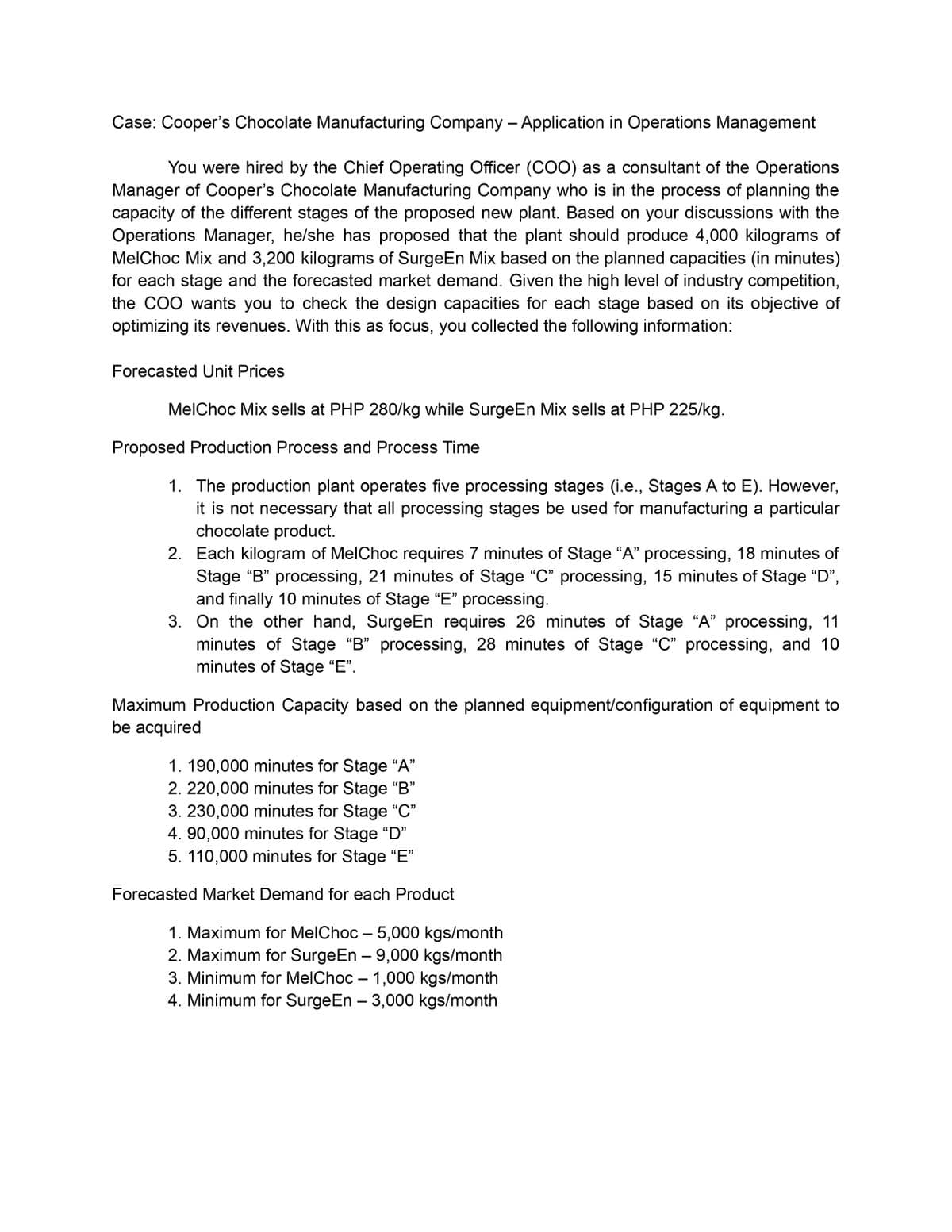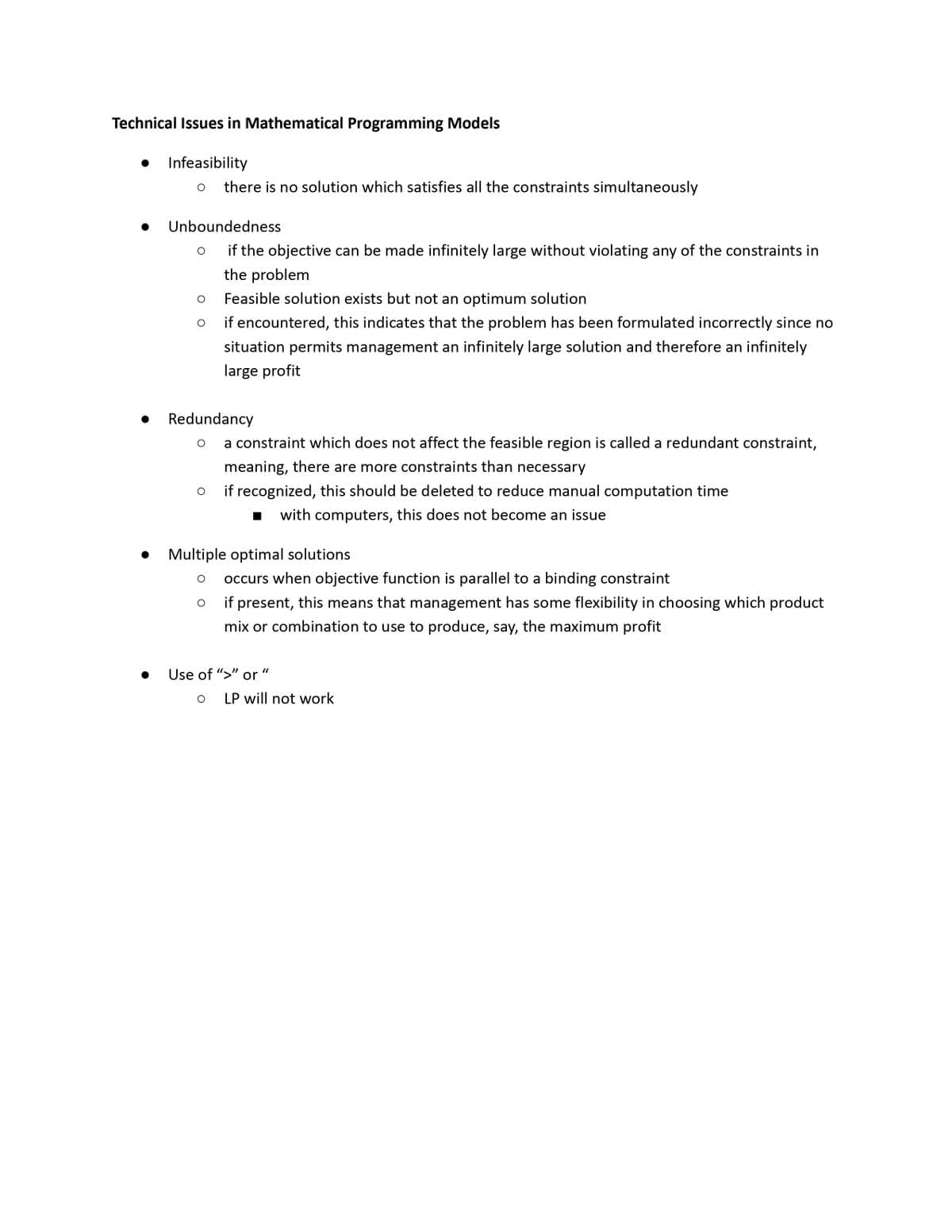Case: Cooper's Chocolate Manufacturing Company - Application in Operations Management You were hired by the Chief Operating Officer (COO) as a consultant of the Operations Manager of Cooper's Chocolate Manufacturing Company who is in the process of planning the capacity of the different stages of the proposed new plant. Based on your discussions with the Operations Manager, he/she has proposed that the plant should produce 4,000 kilograms of MelChoc Mix and 3,200 kilograms of SurgeEn Mix based on the planned capacities (in minutes) for each stage and the forecasted market demand. Given the high level of industry competition, the COO wants you to check the design capacities for each stage based on its objective of optimizing its revenues. With this as focus, you collected the following information: Forecasted Unit Prices MelChoc Mix sells at PHP 280/kg while SurgeEn Mix sells at PHP 225/kg. Proposed Production Process and Process Time 1. The production plant operates five processing stages (i.e., Stages A to E). However, it is not necessary that all processing stages be used for manufacturing a particular chocolate product. 2. Each kilogram of MelChoc requires 7 minutes of Stage "A" processing, 18 minutes of Stage "B" processing, 21 minutes of Stage "C" processing, 15 minutes of Stage "D", and finally 10 minutes of Stage "E" processing. 3. On the other hand, SurgeEn requires 26 minutes of Stage "A" processing, 11 minutes of Stage "B" processing, 28 minutes of Stage "C" processing, and 10 minutes of Stage "E". Maximum Production Capacity based on the planned equipment/configuration of equipment to be acquired 1. 190,000 minutes for Stage "A" 2. 220,000 minutes for Stage "B" 3. 230,000 minutes for Stage “C" 4. 90,000 minutes for Stage "D" 5. 110,000 minutes for Stage "E" Forecasted Market Demand for each Product 1. Maximum for MelChoc - 5,000 kgs/month 2. Maximum for SurgeEn – 9,000 kgs/month 3. Minimum for MelChoc – 1,000 kgs/month 4. Minimum for SurgeEn - 3,000 kgs/month
Case: Cooper's Chocolate Manufacturing Company - Application in Operations Management You were hired by the Chief Operating Officer (COO) as a consultant of the Operations Manager of Cooper's Chocolate Manufacturing Company who is in the process of planning the capacity of the different stages of the proposed new plant. Based on your discussions with the Operations Manager, he/she has proposed that the plant should produce 4,000 kilograms of MelChoc Mix and 3,200 kilograms of SurgeEn Mix based on the planned capacities (in minutes) for each stage and the forecasted market demand. Given the high level of industry competition, the COO wants you to check the design capacities for each stage based on its objective of optimizing its revenues. With this as focus, you collected the following information: Forecasted Unit Prices MelChoc Mix sells at PHP 280/kg while SurgeEn Mix sells at PHP 225/kg. Proposed Production Process and Process Time 1. The production plant operates five processing stages (i.e., Stages A to E). However, it is not necessary that all processing stages be used for manufacturing a particular chocolate product. 2. Each kilogram of MelChoc requires 7 minutes of Stage "A" processing, 18 minutes of Stage "B" processing, 21 minutes of Stage "C" processing, 15 minutes of Stage "D", and finally 10 minutes of Stage "E" processing. 3. On the other hand, SurgeEn requires 26 minutes of Stage "A" processing, 11 minutes of Stage "B" processing, 28 minutes of Stage "C" processing, and 10 minutes of Stage "E". Maximum Production Capacity based on the planned equipment/configuration of equipment to be acquired 1. 190,000 minutes for Stage "A" 2. 220,000 minutes for Stage "B" 3. 230,000 minutes for Stage “C" 4. 90,000 minutes for Stage "D" 5. 110,000 minutes for Stage "E" Forecasted Market Demand for each Product 1. Maximum for MelChoc - 5,000 kgs/month 2. Maximum for SurgeEn – 9,000 kgs/month 3. Minimum for MelChoc – 1,000 kgs/month 4. Minimum for SurgeEn - 3,000 kgs/month
Purchasing and Supply Chain Management
6th Edition
ISBN:9781285869681
Author:Robert M. Monczka, Robert B. Handfield, Larry C. Giunipero, James L. Patterson
Publisher:Robert M. Monczka, Robert B. Handfield, Larry C. Giunipero, James L. Patterson
ChapterC: Cases
Section: Chapter Questions
Problem 5.3SD: Scenario 4 Sharon Gillespie, a new buyer at Visionex, Inc., was reviewing quotations for a tooling...
Related questions
Question
100%
Hi, we are currently learning about Mathematical Programming.
Using the Solver - Add In in Excel and graphical solution, we are tasked to:
- Identify the specific technical issue(s) present in the problem and enumerate the constraints that fall under each technical issue. Explain why you classified these constraints under a specific technical issue.
Attached below are the case narrative and list of technical issues for easy reference. Thank you.

Transcribed Image Text:Case: Cooper's Chocolate Manufacturing Company – Application in Operations Management
You were hired by the Chief Operating Officer (COO) as a consultant of the Operations
Manager of Cooper's Chocolate Manufacturing Company who is in the process of planning the
capacity of the different stages of the proposed new plant. Based on your discussions with the
Operations Manager, he/she has proposed that the plant should produce 4,000 kilograms of
MelChoc Mix and 3,200 kilograms of SurgeEn Mix based on the planned capacities (in minutes)
for each stage and the forecasted market demand. Given the high level of industry competition,
the COO wants you to check the design capacities for each stage based on its objective of
optimizing its revenues. With this as focus, you collected the following information:
Forecasted Unit Prices
MelChoc Mix sells at PHP 280/kg while SurgeEn Mix sells at PHP 225/kg.
Proposed Production Process and Process Time
1. The production plant operates five processing stages (i.e., Stages A to E). However,
it is not necessary that all processing stages be used for manufacturing a particular
chocolate product.
2. Each kilogram of MelChoc requires 7 minutes of Stage "A" processing, 18 minutes of
Stage "B" processing, 21 minutes of Stage "C" processing, 15 minutes of Stage "D",
and finally 10 minutes of Stage "E" processing.
3. On the other hand, SurgeEn requires 26 minutes of Stage "A" processing, 11
minutes of Stage "B" processing, 28 minutes of Stage "C" processing, and 10
minutes of Stage "E".
Maximum Production Capacity based on the planned equipment/configuration of equipment to
be acquired
1. 190,000 minutes for Stage "A"
2. 220,000 minutes for Stage "B"
3. 230,000 minutes for Stage "
4. 90,000 minutes for Stage “D"
5. 110,000 minutes for Stage "E"
Forecasted Market Demand for each Product
1. Maximum for MelChoc – 5,000 kgs/month
2. Maximum for SurgeEn – 9,000 kgs/month
3. Minimum for MelChoc – 1,000 kgs/month
4. Minimum for SurgeEn – 3,000 kgs/month

Transcribed Image Text:Technical Issues in Mathematical Programming Models
Infeasibility
there is no solution which satisfies all the constraints simultaneously
Unboundedness
if the objective can be made infinitely large without violating any of the constraints in
the problem
Feasible solution exists but not an optimum solution
if encountered, this indicates that the problem has been formulated incorrectly since no
situation permits management an infinitely large solution and therefore an infinitely
large profit
Redundancy
a constraint which does not affect the feasible region is called a redundant constraint,
meaning, there are more constraints than necessary
if recognized, this should be deleted to reduce manual computation time
with computers, this does not become an issue
Multiple optimal solutions
occurs when objective function is parallel to a binding constraint
if present, this means that management has some flexibility in choosing which product
mix or combination to use to produce, say, the maximum profit
Use of ">" or "
LP will not work
Expert Solution
This question has been solved!
Explore an expertly crafted, step-by-step solution for a thorough understanding of key concepts.
Step by step
Solved in 2 steps with 6 images

Recommended textbooks for you

Purchasing and Supply Chain Management
Operations Management
ISBN:
9781285869681
Author:
Robert M. Monczka, Robert B. Handfield, Larry C. Giunipero, James L. Patterson
Publisher:
Cengage Learning

Practical Management Science
Operations Management
ISBN:
9781337406659
Author:
WINSTON, Wayne L.
Publisher:
Cengage,

Management, Loose-Leaf Version
Management
ISBN:
9781305969308
Author:
Richard L. Daft
Publisher:
South-Western College Pub

Purchasing and Supply Chain Management
Operations Management
ISBN:
9781285869681
Author:
Robert M. Monczka, Robert B. Handfield, Larry C. Giunipero, James L. Patterson
Publisher:
Cengage Learning

Practical Management Science
Operations Management
ISBN:
9781337406659
Author:
WINSTON, Wayne L.
Publisher:
Cengage,

Management, Loose-Leaf Version
Management
ISBN:
9781305969308
Author:
Richard L. Daft
Publisher:
South-Western College Pub